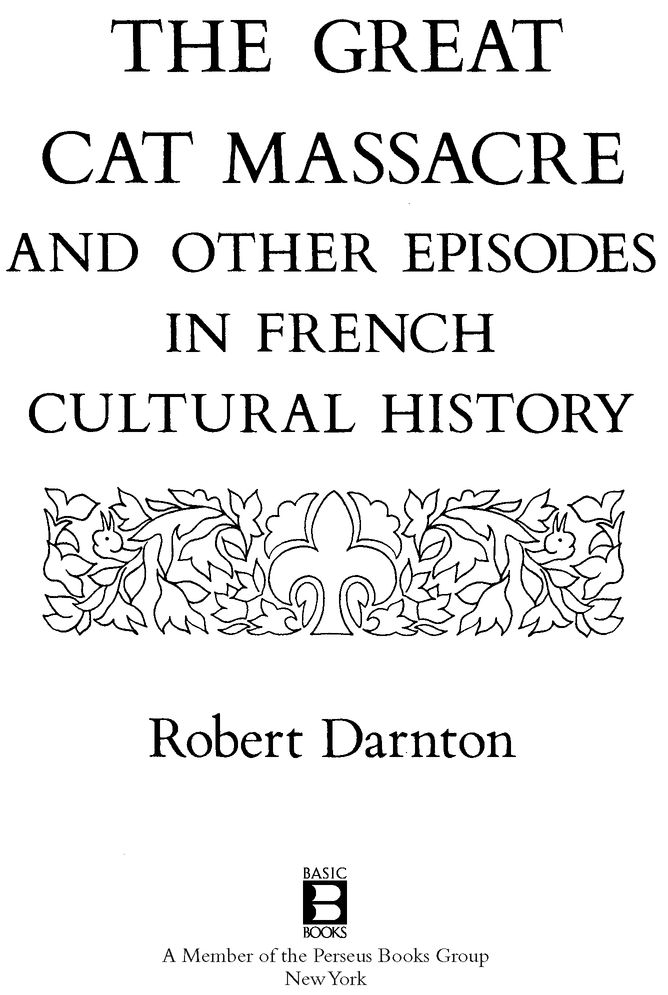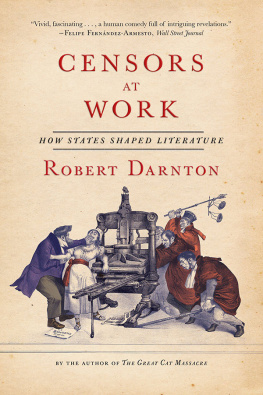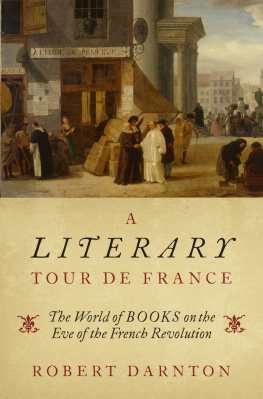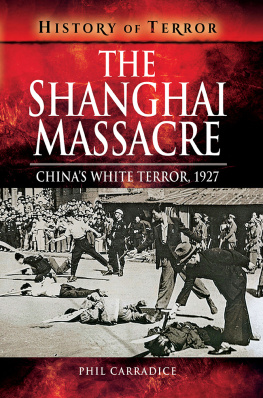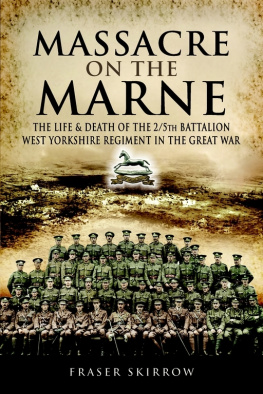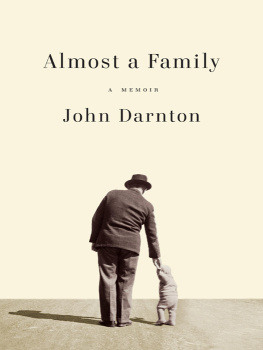Table of Contents
Table of Figures
for Nicholas
ACKNOWLEDGMENTS
THIS BOOK grew out of a course, History 406, that I have offered at Princeton University since 1972. Originally an introduction to the history of mentalits, the course developed into a seminar on history and anthropology, thanks to the influence of Clifford Geertz, who has taught the course with me for the last six years and in doing so has taught me most of what I know about anthropology. I should like to express my gratitude to him and to our students. I also owe a great deal to the Institute for Advanced Study at Princeton, where I began writing this book as a member of a program on self-perception and historical change financed by the Andrew W. Mellon Foundation. And finally, I would like to thank the John D. and Catherine T. MacArthur Foundation whose award of a prize fellowship made it possible for me to suspend my normal work in order to follow up and finish what must have appeared to be a risky enterprise.
PREFACE TO THE REVISED EDITION OF THE GREAT CAT MASSACRE
THIS NEW EDITION of my book gives me an opportunity to address new readers, and I am happy to take advantage of it. Publishing a book is similar to throwing a stone down a deep well: you wait and wait, expecting to hear a splash, but sometimes you hear nothing. Of all the books I have written, The Great Cat Massacre made the greatest splashperhaps, as some have said, because it has a catchy title. When the title caught their eye, readers apparently were intrigued. Why, they asked, should a serious historian occupy himself with such a bizarre event as the ritual slaughter of cats in an obscure neighborhood of eighteenth-century Paris? I hope that question will draw readers into the text and, more importantly, into a new kind of history.
In the 1960s, when everything new seemed to originate on the Left Bank of Paris, this history was heralded as lhistoire des mentalitsthe history of mentalities, or the study of the mental universe of ordinary people. Before then, historians had concentrated on the intellectual life of the elite, but they could not deny that peasants and workers had ideas, too. If some way could be found to penetrate into the worldview of the masses and study the values and attitudes of people in the bottom ranks of society, a whole new dimension of history would open up. But the problems posed by this kind of research seemed to be insurmountable. Most Europeans were illiterate before the nineteenth century. How could a historian find traces of mental activity by people who had left no written record of it?
The first attempts to find a solution to this problem produced some inferences but little in the way of rigorous argument. Historians studied chapbooks that were read aloud to peasants. They compiled statistics from wills, which suggested how the poor imagined the afterlife. They investigated exotic subjects like witchcraft, magic, banditry, and folk medicine. But they did not make systematic advances into this field of study until they began borrowing concepts and methods from a neighboring discipline, anthropology.
Anthropologists had made the worldviews and value systems of illiterate people a principal subject of their research since the beginning of the twentieth century. To be sure, they divided into rival camps and disagreed among themselves just as heartily as historians do, so their concepts could not be imported wholesale into history. But by the 1990s historians were making such effective use of so many varieties of anthropology that even the French abandoned their trademark notion of the history of mentalities and took up anthropological history.
The Great Cat Massacre, first published in 1984, is an early attempt to write history in this vein. I intended it for the general reading public as well as for scholars, so I did not include much in the way of theoretical discourse. I wanted to show how anthropological history could work by writing it instead of writing a treatise on how it should be written. I also adopted a particular strategy in my mode of exposition. I began with the general stock of folk tales, which existed everywhere and reached everyone, among the elite as well as the peasants, through the many dialects that proliferated in eighteenth-century France. By systematically studying and comparing the versions recorded by folklorists in the nineteenth century, I thought it possible to characterize an oral tradition that expressed a general orientation to the worldnot a national spirit, as some of my critics have claimed, but a pattern of culture that existed on a national scale, despite regional variations. Having established this pattern as a general background, I went on in the succeeding chapters to produce a series of case studies, which covered different social groups and led ultimately to the intellectual elite among writers and readers. By proceeding in this manner, I attempted to write cultural history from below, just as earlier historians had treated social and economic historythat is, I began in the world of peasants and artisans and worked up into the world of the Enlightenment. But I did not try to integrate everything into a single, seamless account of eighteenth-century French culture because I do not believe that any such thing existed. Like many modern or postmodern writers, I did not worry about presenting my work in a fragmented and nonholistic way. But I did fret over the need to be rigorousto deploy evidence in a manner that supports a compelling interpretation.
I stress interpretation because I understand history, like all the human sciences, to be interpretive by its very nature. It makes sense of how other people made sense of the human condition. To study a cultural episode like the massacre of cats is similar to going to a play: you read the actions of the actors in order to understand what they are expressing.You dont reach a conclusion comparable to the bottom line of a bank account or the verdict of a judge, because interpretive history is necessarily open-ended, capacious enough to admit many nuances. But open-endedness does not mean that anything goes or that an interpretation cannot be wrong.To interpret Hamlet as a slapstick comedy is to get it wrong, even though other interpretations can be both valid and divergentthose, for example, that construe Hamlet as a play about psychological forces as opposed to those that see it as a drama about power in the body politic.
I have borrowed these ideas from Clifford Geertz, a master anthropologist with whom I taught a seminar on history and anthropology for twenty years. But they also fit the views of Victor Turner, Mary Douglas, E. E. Evans-Pritchard, and younger scholars such as Keith Basso and James Clifford. For all their differences, these anthropologists stress the multivocal character of symbols, and they understand rituals as complex patterns of behavior, which express multiple meanings.
I stress the complexity and multiplicity inherent in symbolic expression because some of my critics have failed to take account of that fundamental point. Roger Chartier, for example, argues that symbols link signifier to signified in an unambiguous, linear manner, as in an example he took from an eighteenth-century dictionary: the lion is the symbol of valor. I would agree that the figure of a lion can suggest valor, but it can also convey strength, ferocity, royalty, and other qualities, including various combinations of them, all at the same time. Anthropologists have demonstrated again and again that ordinary people manipulate symbols in this manner. So there is nothing extravagant about the notion that cats symbolized witchcraft, sexuality, and domesticityor that the ritual murder of them was meant simultaneously as a trial, a gang rape, a rebellion of the workers against their boss, and a carnivalesque kind of street theater, which the workers later repeated in the form of pantomime. Not all of the men who staged the massacre understood it in the same fashion. It had a wide range of meanings that could be construed and combined in several ways. To reduce them to one conclusion, as in the ending of a whodunit mystery story, is to misunderstand the way humans make meaning in general and how workers were able to twit their bosses in the eighteenth century.


